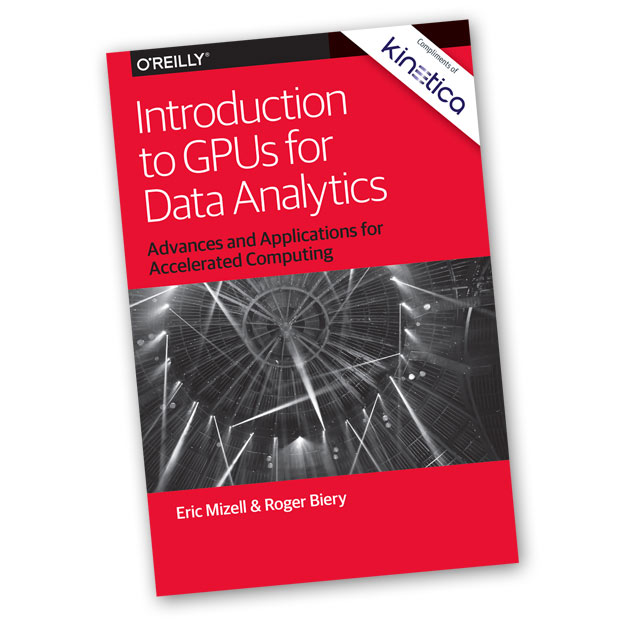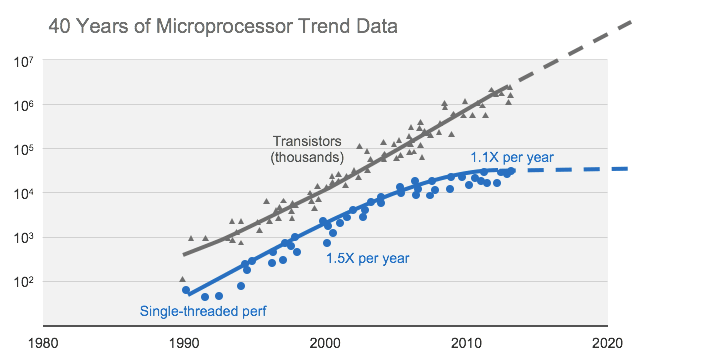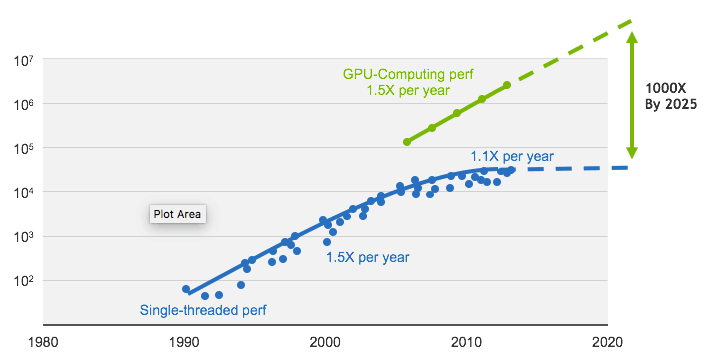The new O’Reilly book, Introduction to GPUs for Data Analytics, co-authored by our own Eric Mizell is now available! This is the first book to outline how advances in accelerated computing technology can be leveraged to address current and future database and big data analytics challenges.

This book is available for download as an ebook from Kinetica. Or, if you’ll be at Strata in NYC this week, stop by our booth for a free hardcopy.
Here’s a quick overview of what’s inside!
What happens now that Moore’s Law has run its course?
After decades of achieving steady gains in price and performance, Moore’s Law has finally run its course for CPUs. Why? It’s because we’ve reached the upper limit of how many x86 cores can be cost-effectively placed on a single chip. Due to this limitation, we’ve seen an influx in the rise of server farms and clusters that are used to scale private and public cloud infrastructures. But such brute force scaling is expensive, and it’s clear that there are only so much space, power, and cooling resources available in data centers to handle.


Fortunately, there’s a much more capable and cost-effective alternative for scaling compute performance for database, big data analytics, and machine learning applications: the graphics processing unit, or GPU. GPUs are proven in practice in a wide variety of applications, and advances in their design make them ideal for keeping up with the data deluge confronting organizations today.
Chapter 1: The Evolution of Data Analytics
Data processing has evolved continuously and considerably since its origins in mainframe computers. This chapter takes a look at the historical context leading to today’s biggest challenge: the shifting bottleneck from memory I/O to compute for a growing number of applications.
Chapter 2: GPUs: A Breakthrough Technology
GPUs have overcome the compute-bound limitation to enable continued price and performance gains. GPUs are capable of processing data up to 100 times faster than configurations containing CPUs alone, due to their massively parallel processing capabilities. Whether in a single server or a cluster, the GPU database delivers a clear and potentially substantial price/performance advantage.
Chapter 3: New Possibilities
There are many database and data analytics applications that stand to benefit from GPU acceleration. This chapter describes how you can use GPU acceleration to improve both the performance and price of a wide variety of database, data analytics, and business intelligence (BI) applications.
Chapter 4: Machine Learning and Deep Learning
Machine learning (ML) and deep learning (DL) have emerged as viable technologies for helping organizations progress from deep analytics to predictive analytics by discovering actionable insights in the data. GPU databases with user-defined functions simplify and accelerate the machine learning/deep learning pipeline.
Chapter 5: The Internet of Things and Real-Time Data Analytics
Only the GPU database has the processing power and other capabilities needed to take full advantage of the IoT. The ability to perform repeated, similar instructions in parallel across a massive number of small, efficient cores makes the GPU ideal for processing streaming data from the Internet of Things and other sources in real time.
Chapter 6: Interactive Location-Based Intelligence
The GPU is especially well-suited to processing geospatial algorithms on large datasets in real time, and rendering the results in map-based graphics that display almost instantly on ordinary browsers. This ability to interact with geospatial data in real time gives business analysts the power to make better decisions faster.
Chapter 7: Cognitive Computing: The Future of Analytics
Cognitive computing, the most compute-intensive application currently imaginable, is now within reach using GPUs. Cognitive computing applications will need to utilize the full spectrum of analytical processes-business intelligence, AI, machine learning, deep learning, natural-language processing, text search and analytics, pattern recognition, and more. Every one of these processes can be accelerated using GPUs.
Chapter 8: Getting Started
Learn how to begin implementing GPU-accelerated solutions on-premise and in public, private, and hybrid cloud architectures. Research your options and choose a solution that can meet all of your analytical needs, scale as you require, and be purpose-built to take full advantage of the GPU.
Sound interesting? Download your FREE copy today!

